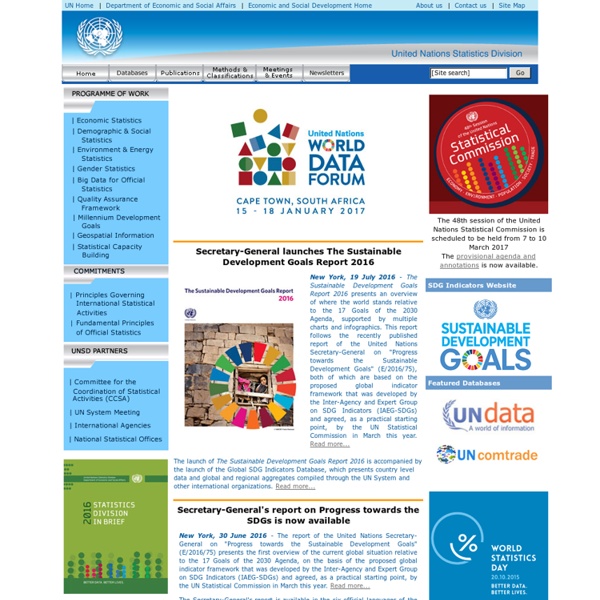



http://unstats.un.org/unsd/default.htm
The World Factbook People from nearly every country share information with CIA, and new individuals contact us daily. If you have information you think might interest CIA due to our foreign intelligence collection mission, there are many ways to reach us. If you know of an imminent threat to a location inside the U.S., immediately contact your local law enforcement or FBI Field Office. For threats outside the U.S., contact CIA or go to a U.S. UNdata COMET Welcome to the CoMET website CoMET is a programme of international railway benchmarking. It is made up of a consortium of large metro systems from around the world - Beijing, Berlin, Guangzhou, Hong Kong, London, Mexico City, Madrid, Moscow, New York, Paris, Santiago, Shanghai, Sao Paulo and Taipei. The four main objectives of CoMET are: 1.
Annuaire B2B Le commerce Inter-entreprise ou B to B Le busines to business ou B2B désigne les activités commerciales d'une entreprise visant une clientèle d'entreprises. Sur Internet, le commerce électronique interentreprises est généralement réalisé par l'intermédiare de plateformes privées ou publiques qui réalisent la mise en relation des acheteurs avec leurs fournisseurs. Les places de marché électroniques privées (B2B eMarketplaces) sont des solutions logiciels en réseau qui aident les entreprises à trouver produits et fournisseurs et optimiser leur approvisionnement stratégique. Parmi les plus utilisées, on citera Ariba, BasWare, cc-Hubwoo (France), Esize (Pays-Bas), Fieldglass, IBX, Perfect Commerce, ProActis, Quadrem et SciQuest. En 2012, les professionnels sont majoritairement utilisateurs d'Internet pour passer leurs commandes (73%) mais continuent pour 51% d'entre-eux à consulter le catalogue papier des fournisseurs.
World Wealth Report 2011 Wealth and population of global HNWIs surpass pre-crisis levels in nearly every region as HNWI wealth reaches US$42.7 trillion The world’s high net worth individuals (HNWIs) expanded in population and wealth in 2010 surpassing 2007 pre-crisis levels in nearly every region, according to the 15th annual World Wealth Report from Merrill Lynch Global Wealth Management and Capgemini. The World Wealth Report covers 71 countries in the market-sizing model, accounting for more than 98% of global gross national income and 99% of world stock market capitalization. The report has built a strong and lasting reputation as the industry benchmark for HNWIs market sizing—originally at a global and regional level but increasingly at a country level. Download the Report to learn more about trends in HNWI wealth worldwide.
Bases de données des Nations Unies UN Comtrade Interrogez les bases de données des statistiques sur le commerce des produits de base (Comtrade) qui stockent plus d'un milliard de données commerciales depuis 1962. Plus de 140 pays fournissent, à la Division des statistique des Nations Unies, leurs données annuelles détaillées du commerce international par produit et pays partenaires. Elles sont consultables dans la limite de 50 000 dossiers. Harvard - Online Data Sources Online Data Sources Political Governance Stability
UK Third Sector Trends Study Northern Rock Foundation’s Third Sector Trends Study is a ground-breaking research programme on the scale, dynamics and needs of the voluntary, community and social enterprise sector in North East England and Cumbria. The Study is for the first time providing robust, comprehensive and freely available local and regional evidence to describe the sector. The Study will help sector organisations, infrastructure agencies, funders and government bodies who all need better information about the characteristics and activities of the third sector groups.
Open data An introductory overview of Linked Open Data in the context of cultural institutions. Clear labeling of the licensing terms is a key component of Open data, and icons like the one pictured here are being used for that purpose. Overview[edit] The concept of open data is not new; but a formalized definition is relatively new—the primary such formalization being that in the Open Definition which can be summarized in the statement that "A piece of data is open if anyone is free to use, reuse, and redistribute it — subject only, at most, to the requirement to attribute and/or share-alike
General Social Survey The GSS contains a standard 'core' of demographic, behavioral, and attitudinal questions, plus topics of special interest. Many of the core questions have remained unchanged since 1972 to facilitate time-trend studies as well as replication of earlier findings. The GSS takes the pulse of America, and is a unique and valuable resource. It has tracked the opinions of Americans over the last four decades. Trends American Time Use Survey Home Page The American Time Use Survey (ATUS) measures the amount of time people spend doing various activities, such as paid work, childcare, volunteering, and socializing. In 2015, 38% of workers in management do some work from home on days they work In 2015, 38 percent of workers in management, business, and financial operations occupations, and 35 percent of workers in professional and related occupations, did some or all of their work from home on days they worked. Workers in other occupations were less likely to work from home. HTML | PDF | RSS